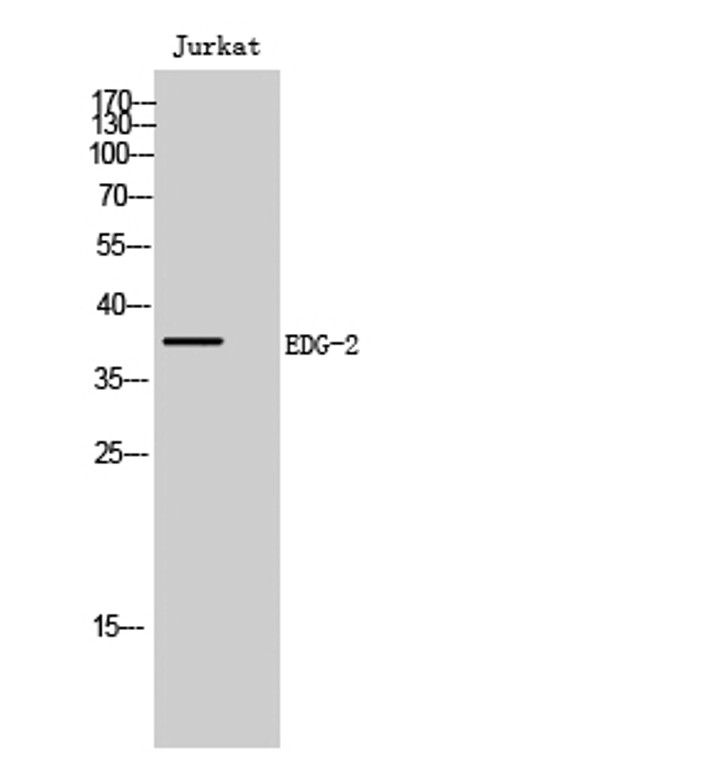| Host: |
Rabbit |
| Applications: |
WB/IHC/IF/ELISA |
| Reactivity: |
Human/Rat |
| Note: |
STRICTLY FOR FURTHER SCIENTIFIC RESEARCH USE ONLY (RUO). MUST NOT TO BE USED IN DIAGNOSTIC OR THERAPEUTIC APPLICATIONS. |
| Short Description: |
Rabbit polyclonal antibody anti-Lysophosphatidic acid receptor 1 (5-54 aa) is suitable for use in Western Blot, Immunohistochemistry, Immunofluorescence and ELISA research applications. |
| Clonality: |
Polyclonal |
| Conjugation: |
Unconjugated |
| Isotype: |
IgG |
| Formulation: |
Liquid in PBS containing 50% Glycerol, 0.5% BSA and 0.02% Sodium Azide. |
| Purification: |
The antibody was affinity-purified from rabbit antiserum by affinity-chromatography using epitope-specific immunogen. |
| Concentration: |
1 mg/mL |
| Dilution Range: |
WB 1:500-1:2000IHC 1:100-1:300IF 1:200-1:1000ELISA 1:5000 |
| Storage Instruction: |
Store at-20°C for up to 1 year from the date of receipt, and avoid repeat freeze-thaw cycles. |
| Gene Symbol: |
LPAR1 |
| Gene ID: |
1902 |
| Uniprot ID: |
LPAR1_HUMAN |
| Immunogen Region: |
5-54 aa |
| Specificity: |
EDG-2 Polyclonal Antibody detects endogenous levels of EDG-2 protein. |
| Immunogen: |
The antiserum was produced against synthesized peptide derived from the human EDG2 at the amino acid range 5-54 |
| Post Translational Modifications | N-glycosylated. |
| Function | Receptor for lysophosphatidic acid (LPA). Plays a role in the reorganization of the actin cytoskeleton, cell migration, differentiation and proliferation, and thereby contributes to the responses to tissue damage and infectious agents. Activates downstream signaling cascades via the G(i)/G(o), G(12)/G(13), and G(q) families of heteromeric G proteins. Signaling inhibits adenylyl cyclase activity and decreases cellular cAMP levels. Signaling triggers an increase of cytoplasmic Ca(2+) levels. Activates RALA.this leads to the activation of phospholipase C (PLC) and the formation of inositol 1,4,5-trisphosphate. Signaling mediates activation of down-stream MAP kinases. Contributes to the regulation of cell shape. Promotes Rho-dependent reorganization of the actin cytoskeleton in neuronal cells and neurite retraction. Promotes the activation of Rho and the formation of actin stress fibers. Promotes formation of lamellipodia at the leading edge of migrating cells via activation of RAC1. Through its function as LPA receptor, plays a role in chemotaxis and cell migration, including responses to injury and wounding. Plays a role in triggering inflammation in response to bacterial lipopolysaccharide (LPS) via its interaction with CD14. Promotes cell proliferation in response to LPA. Inhibits the intracellular ciliogenesis pathway in response to LPA and through AKT1 activation. Required for normal skeleton development. May play a role in osteoblast differentiation. Required for normal brain development. Required for normal proliferation, survival and maturation of newly formed neurons in the adult dentate gyrus. Plays a role in pain perception and in the initiation of neuropathic pain. |
| Protein Name | Lysophosphatidic Acid Receptor 1Lpa Receptor 1Lpa-1Lysophosphatidic Acid Receptor Edg-2 |
| Database Links | Reactome: R-HSA-416476Reactome: R-HSA-418594Reactome: R-HSA-419408 |
| Cellular Localisation | Cell SurfaceCell MembraneMulti-Pass Membrane ProteinEndosomePrior To Lpa Treatment Found Predominantly At The Cell SurfaceInternalized After Lpa TreatmentColocalizes With Rala In Endocytic Vesicles After Lpa Treatment |
| Alternative Antibody Names | Anti-Lysophosphatidic Acid Receptor 1 antibodyAnti-Lpa Receptor 1 antibodyAnti-Lpa-1 antibodyAnti-Lysophosphatidic Acid Receptor Edg-2 antibodyAnti-LPAR1 antibodyAnti-EDG2 antibodyAnti-LPA1 antibody |
Information sourced from Uniprot.org
12 months for antibodies. 6 months for ELISA Kits. Please see website T&Cs for further guidance











